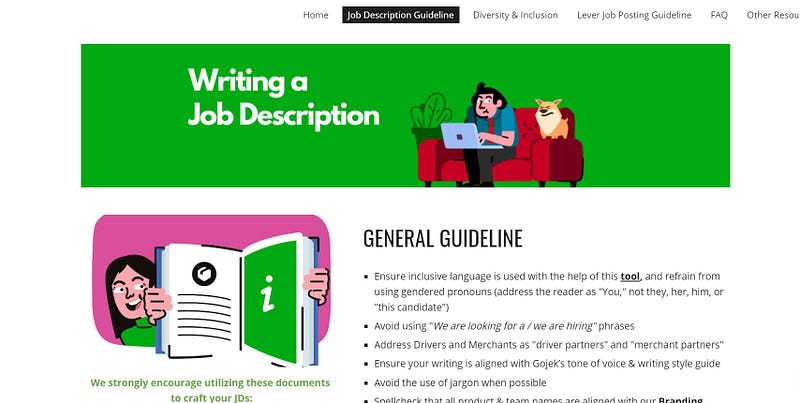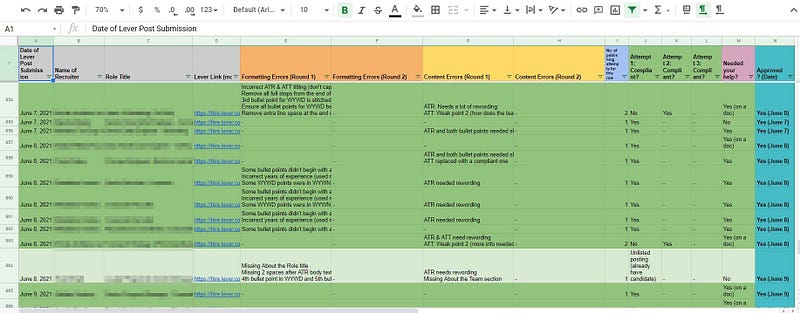Executing an Extreme Makeover
A content writer's quest in editing 3300+ Job Descriptions.

By Pamela Chan
A job description (JD) is arguably the most essential component of a hiring process; it not only gets the ball rolling, but rolling in the right direction. Just like a fishing pole with a juicy piece of bait, or a restaurant menu with glistening photographs of their delectable treats, the more enticing a job description, the more talent it will attract. The problem was that our job descriptions were in disarray.
Recruiters could write and publish JDs at their own discretion, resulting in inconsistent postings in terms of formatting, writing style, content, and grammar. While prior attempts have been made to standardize this process, the sustainability and centrality of such attempts have been deficient.
✨ Enter: the JD Clean Up Team ✨
Our sole purpose was to completely restructure our JD writing and approval process. As the team’s content writer, I was in charge of developing and executing an overarching JD writing framework for our Talent Acquisition team to utilize. Armed with a pen and a love of writing, this is how I went about editing and approving over 3,300 JDs for Gojek.

So, what’s the problem here?
First things first, you’ll need to fully understand the problem points. Throughout my first three weeks at Gojek, I had set up 1-on-1 calls with over 15 recruiters to gather insight on their JD writing frustrations.
The three most recurring issues were: misunderstandings between recruiters and hiring managers, not knowing what to include in each JD, and a difficulty communicating “dry” information appealingly. The common thread throughout these concerns was the absence of a centralized writing framework.
I also conducted deep dives into as many past and active JDs as I could find. This helped me identify the most persistent JD mistakes and inconsistencies firsthand.
When there’s no road forward, make one
With a strong grasp of what went wrong, it’s time to set things right. One of the most effective ways to steer a team in a specific direction is to create supporting documentation that everyone can lean on.
The three primary resources I crafted were:
- An Action Plan: An internal document that explains the rationale behind our JD Clean Up project and the power of a well-written JD.
- A JD Content Template: Using the feedback gathered from my interviews with recruiters, I crafted a step-by-step JD writing guide. It’s designed in a way that allows our recruiters to follow the predefined steps to craft their JDs from scratch, or simply plug their specific information into the pre-written paragraphs. Our Content Template has significantly streamlined the JD writing and editing process. What would normally take a week to draft up now took less than a day.
- An Exemplary JD doc: As a writer, I find it helpful to see examples of the kind of writing I’m tasked to produce. With this document of four outstanding JDs written by their colleagues, recruiters can see the precise writing style, formatting, tone of voice, and all required points in action.
Additionally, I frequently updated our one-stop JD Google Site set up by our team leads. Here, recruiters and hiring managers can find our format and content requirements laid out in detail, as well as more technical instructions on how to submit a JD for approval.

Move the needle slowly
Turns out, creating the resources was the easy part. Getting buy-in from stakeholders to actually refer to and utilize these resources was the challenge.
Which, to be fair, is understandable: Going from zero rules to stringent measures necessitates a big cultural shift.
As with any change, it takes time for new rules to be accepted as part of the work culture.
A rule of thumb: Move the needle slowly. Sudden, large-scale changes will most likely be met with strong resentment. The first step was rolling out broad, easy-to-follow requirements to acclimate our stakeholders to these revisions (we called this “Phase One”).
Actively engaging with your stakeholders by hosting JD writing workshops, giving short presentations reiterating the available JD resources, and being present to answer any questions they may have will speed up this acceptance process as well.
The Heimdall of JDs
In the efforts to move the needle even further, and to provide our stakeholders with catered support, I was made the sole gatekeeper for all new incoming JDs from December 14, 2020 to April 12, 2021.
Assigning at least one person to this task will centralize the JD proofreading, editing, and approval process for all operating offices. On a daily basis, this person(s) will collaborate with recruiters and hiring managers to ensure all parties are on the same page, and that every JD created meets our set standards.
If a non-compliant JD came through, I would either:
- Rectify any minor formatting errors myself and approve the submission
- Reject the submission and list out the errors the recruiter needs to fix
- Reject the submission and request for the role’s intake form to make edits directly
To keep track of every JD that came in, I created a JD Compliance Spreadsheet that listed the date and number of submissions, errors, and whether the recruiter needed my assistance. This way, if anyone had a questions about a previous JD, I could simply whip out this spreadsheet to answer them.

Within two months, the number of JDs approved on their first submission rose from 52% to 91%.
The final push
Four months after I was made JD gatekeeper, with a majority of recruiters up and running with these changes, we rolled out the new and improved Phase Two of the JD requirements. This version necessitated more specific information to craft well-rounded JDs, leaving no room for misinterpretation between the hiring manager and candidate about the role’s expectations.
For instance, along with the team’s responsibilities within Gojek (e.g. "oversee the user experience for all Commerce Enablement products"), recruiters had to include how the team accomplishes them (e.g. “by participating in end-to-end design processes with peer researchers, designers, and the Product and Engineering teams”). Instead of merely listing “strong management skills” in the What You Will Need section, we pushed back and asked what kind of management skills (people/ project/ stakeholder)? And for what purpose?
By not inundating our recruiters with these rules at the start, and moving the needle inch by inch instead, these added measures were accepted more readily than anticipated.
When all is said and done
This project was no easy feat — from managing the influx of JDs that came in every week, fielding ample frustration on the need for such definite guidelines, getting buy-in from stakeholders, to the actual brain power of editing an average of 500 JDs a month.
However, the pay off was multifold. After all, well-written job descriptions not only ensure the best talents come your way, they also remove any ambiguity or confusion about the role, support clearer employee standing and accountability, and help promote an inclusive and positive employer brand.
As our JD Clean Up team leads Shawn & Janice alluded to in their blog post, there are always improvements to be made. But with the roadmap set and tools at their disposal, our recruiters can now craft and publish quality JDs at full speed.

Click here to read more stories about how we do what we do.
And we’re hiring! Check out the link below:
